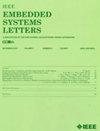TinyMo: Graph-Level Memory Optimizer for Tiny Machine Learning
IF 2
4区 计算机科学
Q3 COMPUTER SCIENCE, HARDWARE & ARCHITECTURE
引用次数: 0
Abstract
Effective memory optimization is essential for tiny machine learning because tiny embedded systems generally have limited memory for model execution. Previous research has proposed various model compression methods to reduce the memory usage of machine learning models. However, the methods often entail accuracy loss resulting from altering model weights. This letter proposes a graph-level memory optimizer for tiny embedded systems, TinyMo, which optimizes the memory usage of an input model by changing the structure of the model graph. TinyMo mainly uses two optimization methods: 1) tensor spilling and 2) tensor splitting, to reduce unnecessary memory usage from long skip connections and large separable convolutions. In the evaluation, this letter shows that the proposed optimizer can successfully reduce the peak memory usage of various neural network models for commercial embedded systems with little runtime overhead.TinyMo:微型机器学习的图形级内存优化器
有效的内存优化对于微型机器学习至关重要,因为微型嵌入式系统通常只有有限的内存来执行模型。以前的研究提出了各种模型压缩方法来减少机器学习模型的内存使用。然而,这些方法往往会由于模型权重的改变而导致精度损失。这封信提出了一个用于微型嵌入式系统的图级内存优化器TinyMo,它通过改变模型图的结构来优化输入模型的内存使用。TinyMo主要使用两种优化方法:1)张量溢出和2)张量分裂,以减少长跳跃连接和大可分离卷积的不必要内存使用。在评估中,这封信表明,所提出的优化器可以成功地降低商业嵌入式系统中各种神经网络模型的峰值内存使用,并且运行时开销很小。
本文章由计算机程序翻译,如有差异,请以英文原文为准。
求助全文
约1分钟内获得全文
求助全文
来源期刊

IEEE Embedded Systems Letters
Engineering-Control and Systems Engineering
CiteScore
3.30
自引率
0.00%
发文量
65
期刊介绍:
The IEEE Embedded Systems Letters (ESL), provides a forum for rapid dissemination of latest technical advances in embedded systems and related areas in embedded software. The emphasis is on models, methods, and tools that ensure secure, correct, efficient and robust design of embedded systems and their applications.
 求助内容:
求助内容: 应助结果提醒方式:
应助结果提醒方式:


